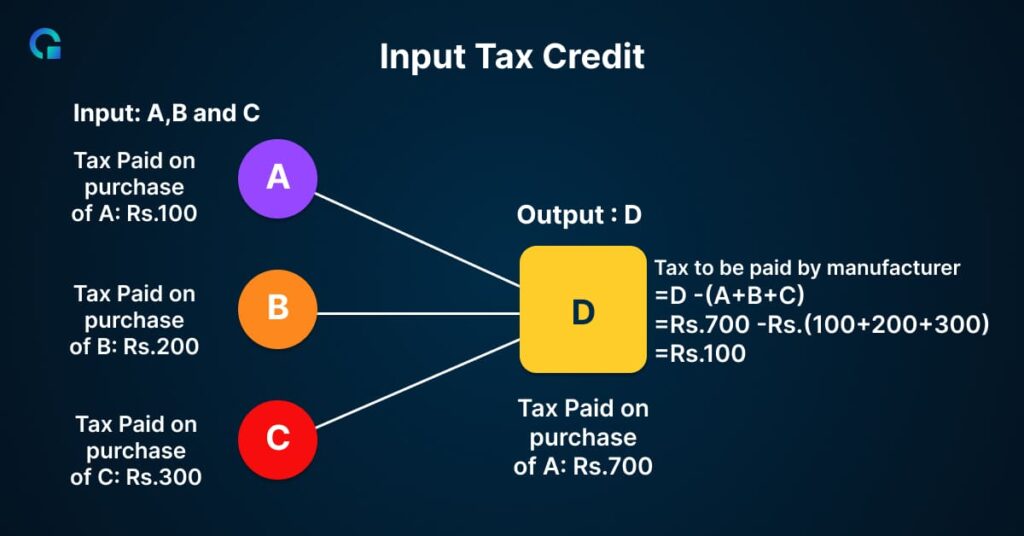Home » A Practical Guide to Input Tax Credit (ITC) under GST
- TRENDING ARTICLE
A Practical Guide to Input Tax Credit (ITC) under GST

Anurag Mittal

Navigating the complexities of the Goods and Services Tax (GST) in India can be challenging, especially when it comes to understanding the concept of Input Tax Credit (ITC). However, if managed correctly, ITC can significantly reduce your tax liabilities and boost your business’s financial efficiency. In this guide, we will break down everything you need to know about ITC under GST, including the eligibility criteria, documentation, utilization rules, and much more.
Table of Contents
ToggleWhat is Input Tax Credit (ITC)?
Input Tax Credit (ITC) is the credit that a business can claim for the tax paid on purchases of goods or services. This credit is used to reduce the GST liability on the sale of goods or services. Essentially, ITC helps to prevent the cascading effect of taxes, ensuring that the end consumer does not bear the brunt of multiple layers of taxation.

A Simple Example
Let’s consider an example to understand this better:
Suppose you run a retail store. You purchase inventory worth ₹1,00,000 with a GST of 18%, which amounts to ₹18,000. Later, you sell the goods for ₹1,50,000, charging 18% GST, which totals ₹27,000. Instead of paying the full ₹27,000 to the government, you can deduct the ₹18,000 you paid as GST on your purchases. Therefore, your net GST liability is only ₹9,000 (₹27,000 – ₹18,000).
Key Conditions for Claiming ITC
To claim ITC, businesses must meet the following conditions:
- To understand how to handle such situations, read our guide on ITC mismatches and DRC-01C notices.Goods or Services Must Be for Business Use: ITC is only available for goods and services used for business purposes. For instance, if you buy office supplies for your company, you can claim ITC. However, if those supplies are used for personal reasons, ITC cannot be claimed.
- Possession of Valid Documents: You must have valid documents, such as a tax invoice, debit note, or other prescribed documents like a bill of entry for imports or self-invoice under the reverse charge mechanism (RCM).
- Receipt of Goods or Services: The goods or services must have been received by you or your agent. If the goods are received in installments, ITC can only be claimed upon receipt of the last installment.
- Supplier Must Have Paid the Tax: The supplier must have filed their GST returns and paid the due tax to the government. If the supplier fails to pay the tax, your ITC claim may be denied.
- Filing of Returns: You must file the required GST returns, such as GSTR-1, GSTR-2B, and GSTR-3B, within the prescribed time limits.
- Payment Within 180 Days: Payment for the supply of goods or services must be made within 180 days from the date of the invoice. If payment is not made within this period, ITC claimed must be reversed, with interest. Once the payment is made, the ITC can be reclaimed.
Example of Non-Compliance
Consider a business that purchased raw materials but failed to pay the supplier within 180 days. The ITC claimed on these purchases must be reversed, along with the applicable interest. The business can reclaim the ITC only after settling the dues with the supplier.
Documents Required for Claiming ITC
To claim ITC, you need to maintain the following documents:
- Tax Invoice or Debit Note: Issued by a registered supplier.
- Bill of Entry: For goods imported into India.
- Self-Invoice: For purchases made from unregistered suppliers under RCM.
- Credit Note: Issued by an Input Service Distributor.
- Other Relevant Documents: Such as an invoice issued by a recipient of goods/services who has paid tax under RCM.
Provisions and Rules for Availing ITC
Relevant Sections of the CGST Act
- Section 16(2)(c): States that ITC can only be claimed if the tax has been paid to the government, either through cash or ITC utilization. If the tax is not paid, the credit must be reversed.
- Section 41(2): Explains the process for credit reversal when the supplier fails to pay the tax. It also allows for re-availing of credit once the tax is eventually paid by the supplier, ensuring that businesses are not penalized for supplier delays.
Special Circumstances for Claiming ITC
Certain special situations allow businesses to claim ITC:
- Compulsory Registration: ITC is available when a business becomes liable for compulsory registration.
- Voluntary Registration: ITC can be claimed from the date of registration.
- Transition from Composition Scheme: When switching from a composition scheme to a regular scheme, ITC is available on stock held on the day before the change.
- Taxable Exempt Supplies Becoming Taxable: ITC can be claimed when supplies previously exempt become taxable.
- Change in Business Constitution: ITC is available in case of a change in the business’s constitution.
Reversal of Input Tax Credit
ITC may need to be reversed in the following situations:
- Non-Payment to Supplier: If you fail to pay the supplier within 180 days.
- Personal Use: If goods or services are used for personal purposes.
- Exempt Supplies: If goods or services are used to provide exempt supplies.
- Sale of Capital Goods: If capital goods on which ITC was claimed are sold.
- Credit Notes from Supplier: If a credit note is issued by an Input Service Distributor.
- Supplies Ineligible Under Section 17(5): ITC must be reversed if supplies are ineligible.
Example of ITC Reversal
If you claimed ITC on machinery purchased for manufacturing taxable goods, but later sold the machinery, you would need to reverse the ITC claimed earlier.
ITC Under Reverse Charge Mechanism (RCM)
When you pay tax under RCM, you can claim ITC in the same month if:
- Payment is Made in Cash: The liability must be discharged in cash.
- Business Use: Goods or services are used for business purposes.
- Self-Invoice is Generated: As an unregistered supplier cannot issue a tax invoice, you must generate a self-invoice.
Time Limits for Claiming ITC
ITC must be claimed before the earlier of the following dates:
- Due Date of Filing GSTR-3B for September: Of the subsequent financial year.
- Date of Filing Annual Return (GSTR-9): For the relevant financial year.
If ITC is not claimed within this period, it will lapse and cannot be utilized.
Example of Time Limit for Claiming ITC
A company purchased goods in December 2022. The last date to claim ITC would be either the due date for filing GSTR-3B for September 2023 or the date of filing GSTR-9 for the financial year 2022-23, whichever is earlier.
Refund of ITC
Refund of unutilized ITC can be claimed in specific scenarios:
- Exports without Payment of IGST: Refund of ITC on exports made without paying IGST.
- Supplies to SEZ Units/Developers: Refund of ITC on goods or services supplied to SEZ units or developers without payment of IGST.
- Inverted Duty Structure: Refund of ITC due to an inverted tax structure, where the tax on inputs is higher than the tax on outputs.
Example of ITC Refund
If you are an exporter supplying goods to the US without paying IGST, you can claim a refund of the unutilized ITC on the input goods used for exports.
Utilization and Set-Off Rules for ITC
Effective from July 1, 2019, ITC must be utilized in the following order:
- IGST Credit: Must be used first to pay IGST, then CGST, and finally SGST/UTGST.
- CGST Credit: To be used for CGST first and then for IGST.
- SGST/UTGST Credit: To be used for SGST/UTGST first and then for IGST.
- Cross-Utilization Not Allowed: CGST cannot be used to set off SGST/UTGST liability and vice versa.
Ineligible ITC: Items Where ITC Cannot Be Claimed
ITC cannot be claimed on:
- Motor Vehicles for Personal Use: Except in certain cases like transport services.
- Insurance and Repairs of Vehicles: Related to motor vehicles.
- Personal Services: Food, beverages, club memberships, beauty treatments, health services, etc.
- Works Contract Services: For the construction of immovable property.
- Composition Scheme Purchases: Goods or services from suppliers under the composition scheme.
- Personal Consumption: Goods or services used for personal consumption.
- Goods Lost or Stolen: Destroyed, written off, or given as free samples.
- Fraudulent Claims: ITC claimed through fraud or willful misstatement.
Example of Ineligible ITC
If a company provides free samples of its products for promotion, it cannot claim ITC on the goods used for these samples.
Conclusion
Understanding and managing Input Tax Credit (ITC) under GST is crucial for optimizing your business’s tax liability. By following the correct procedures, maintaining the required documentation, and staying updated with the latest rules, you can ensure compliance and benefit from the ITC mechanism to its fullest.
Make sure to consult with your tax advisor regularly and refer to the latest government notifications to stay updated on GST regulations.
By including all these points, this blog aims to cover every aspect of ITC under GST comprehensively, ensuring it provides a complete resource for businesses looking to navigate the complexities of GST and optimize their tax strategies
- What is Input Tax Credit (ITC)?
- Documents Required for Claiming ITC
- Provisions and Rules for Availing ITC
- Relevant Sections of the CGST Act
- Special Circumstances for Claiming ITC
- Reversal of Input Tax Credit
- ITC Under Reverse Charge Mechanism (RCM)
- Time Limits for Claiming ITC
- Utilization and Set-Off Rules for ITC
- Ineligible ITC: Items Where ITC Cannot Be Claimed
- Example of Ineligible ITC
- Conclusion
- What is Input Tax Credit (ITC)?
- Documents Required for Claiming ITC
- Provisions and Rules for Availing ITC
- Relevant Sections of the CGST Act
- Special Circumstances for Claiming ITC
- Reversal of Input Tax Credit
- ITC Under Reverse Charge Mechanism (RCM)
- Time Limits for Claiming ITC
- Utilization and Set-Off Rules for ITC
- Ineligible ITC: Items Where ITC Cannot Be Claimed
- Example of Ineligible ITC
- Conclusion
Start using OLAO today
- Get Paid Faster. Boost Cash Flow
- Powerful, automated core accounting
- Hands-free bank reconciliation
Frequently Asked Questions
ITC is the credit a business can claim for the GST paid on purchases, which can be used to reduce the GST liability on sales.
Businesses that use goods or services for business purposes, have valid documents, and comply with GST filing and payment rules can claim ITC.
Required documents include a tax invoice, debit note, bill of entry, self-invoice, or credit note.
ITC needs to be reversed if the supplier is not paid within 180 days, for personal use, or if used for exempt supplies, among other cases.
Refunds can be claimed for exports without IGST, supplies to SEZs, or in cases of an inverted tax structure.

